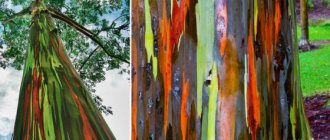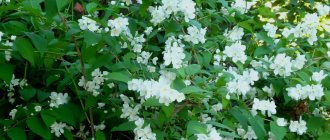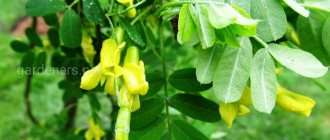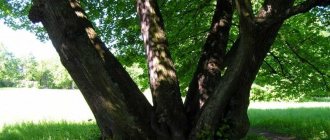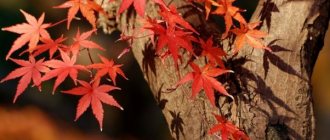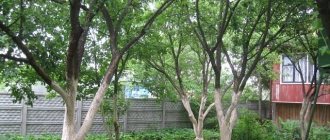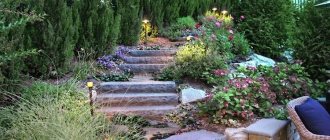Planting trees and shrubs is one of the most important operations in their cultivation. In many ways, it depends on it whether the seedlings will turn into beautiful plants or take on a pitiful appearance, or even die. Let's look at the reasons that determine the success of planting and transplantation.
Of primary importance are: choosing a planting site and healthy seedlings adapted for a given climatic zone; competent carrying out of planting work in the optimal time; proper aftercare.
Time to board
In the spring you should hurry: when the leaves begin to unfurl on the shoots of seedlings, their survival rate decreases sharply. Therefore, the spring planting boom is rapid and fleeting. The autumn planting period is more measured and thorough. It is not profitable for nurseries to leave seedlings in the fields, so in the fall the range of planting material is the richest and there is an opportunity to choose the best.
landscaping of territories
We are talking about seedlings with an open root system freed from the ground. In this state, in dry weather, they can remain in the open air for no more than 15 minutes, after which the most delicate root endings (the basis of the root system), which absorb water, begin to dry out and die. Therefore, when purchasing planting material with an open root system, you need to take care in advance to protect it from drying out and stock up on suitable containers.
Helpful advice
For small plants, you can use boxes (preferably plastic ones with small ventilation holes), for medium-sized plants, garbage bags measuring from 20 to 40 liters are good, for large seedlings you should purchase double polyethylene film up to 1.5 m wide.
Upon arrival at the planting site, seedlings should be buried as quickly as possible.
- To do this, you need to prepare a ditch with one vertical and the other inclined wall (at an angle of 30°), where the seedlings are laid, and their roots are sprinkled with earth.
- The seedlings remain in the dig until planting; after they are removed, the roots cannot be left open for more than 15 minutes.
- Buried seedlings can be stored for quite a long time without losing their viability.
It is better to plant shrubs in the fall, and trees in the spring. This rule is based on the fact that shrubs planted in early autumn (during September) have time to take root in a new place before the winter cold, but trees do not have time and are damaged by frost in winter. Therefore, it is better to leave tree seedlings in storage until spring.
Recommendation
It is best to purchase and transport seedlings with an open root system in cool, cloudy or even rainy weather.
Selection of seats
First you need to assess the conditions in which the planted plants will develop:
- sunny or shaded;
- waterlogged or dry;
- with rich clay or poor sandy soils.
This will make it possible to determine the assortment of trees and shrubs, and, having established the sizes of these areas, to calculate the required amount of planting material.
The most common mistake is to fit too tight. The reason for this is ignorance of what size the plant reaches in adulthood. An authoritative specialist in Europe, Dr. D.G. Hessayon recommends making the following calculations when designing seats:
Rice. 1. Calculation of the distance between tree planting sites
For most trees (with the exception of columnar trees), you need to add the heights of adult trees A and B and divide the resulting sum by two - this will be the optimal distance between the centers of the planting holes (Fig. 1).
Rice. 2. Calculation of the distance between shrub planting sites
For most shrubs, add the height of mature bush A and mature bush B and divide the resulting sum by three (Fig. 2).
Below we give several examples for the most famous trees and shrubs (the height is given for the conditions of the temperate zone of the European part of Russia and corresponds to the age of the plants indicated in brackets)*. |
Trees:
- prickly spruce (typical form) – up to 25 m (80 years);
- English oak – up to 25 m (100 years);
- sycamore maple (holly leaf) – up to 20 m (60 years);
- Tatarian maple – up to 9 m (20 years);
- riverine maple (Ginnala) – up to 6 m (15 years);
- large-leaved linden – up to 25 m (80 years);
- Siberian larch – up to 25 m (80 years);
- white willow (silver) weeping form - up to 20 m (80 years);
- Norway willow – up to 8 m (20 years);
- five-stamen willow – up to 12 m (30 years);
- willow brittle spherical shape - up to 10 m (30 years).
Shrubs:
- common hazel – up to 3 m (10 years);
- European euonymus – up to 2.5 m (10 years);
- sea buckthorn – up to 5 m (10 years);
- privet – up to 3 m (8 years);
- mock orange - up to 3 m (10 years).
- Potentilla (Kuril tea) – 0.4–0.9 m (5 years);
- rhododendron – 2 m (5 years);
- Japanese spirea – 0.6 m (5 years);
- Spiraea Bumold – 0.15–1.5 m (5 years).
The wide range of heights of small shrubs is associated with the presence of a large number of decorative forms and specially bred varieties for each species).
You can set the height of trees at any age you are interested in, for example, 10, 20 or 40 years, using regional growth tables used in forest management.
How to correctly determine the distance between trees and shrubs?
To determine the distance between fruit trees, you need to add up the estimated heights of already mature plants and divide the resulting amount by two. The result will be the required distance between planting holes, which must be observed when planting trees. For example, an apple tree grows 3 meters in height, and a plum tree grows 4 meters, then the distance between them is three and a half meters.
When planting shrubs, the heights of two mature plants growing nearby are added up and the resulting amount is divided by three. These are the requirements of tree plantations for planting.
Preparation of planting holes
The dimensions of the planting holes must correspond to the characteristics of the plant root systems. Nevertheless, even in trees such as English oak and Scots pine, whose skeletal roots go into the soil to a depth of 5–6 m, the bulk (up to 90%) of small suction roots are located in the upper 40-centimeter layer. Therefore, even when planting large trees with a clod, the depth of the planting hole rarely reaches 1 m, and most often it is 60–80 cm.
It is much more important for plants to have the opportunity to develop lateral roots, which, constantly branching, develop the upper, nutrition-rich and well-aerated layers of the soil horizon. These layers are home to a huge number of soil bacteria (up to 5 million per 1 cm3) and fungi, without whose vital activity plant roots cannot exist. Therefore, the width of the landing pit should be made as large as possible, within reasonable limits.
For individual trees and bushes and for group planting, separate holes are dug for each plant, and trenches are prepared to create hedges and borders.
Raspberries
Raspberries are rightly considered the most unpretentious berry bush, but this does not mean at all that this plant can be planted in the backyard of the garden, where the sun almost never shines. Raspberries, indeed, prefer light shading, but only in the hottest midday hours; at all other times, this shrub should be open to sunlight. The same applies to soil moisture: excess moisture can be useful for this berry bush only in regions with a fairly hot climate; in the middle or northern zone, increased soil moisture will lead to the fact that varietal raspberries will often freeze out.
It is also worth paying attention to the distance between the rows of shrubs: in amateur gardens, raspberries often turn into impenetrable thorny thickets, which do not allow for good fruiting and a favorable aesthetic perception of this part of the garden. The most rational distance between rows is 80-140 cm (depending on the raspberry variety); the optimal distance between individual bushes is about 1 m.
Digging a hole:
1. A bayonet shovel is used to cut through the turf - the top layer of soil around the perimeter of the future hole, which should be at least 1 m for trees, and 60 cm for large shrubs.
2. The top fertile layer of soil is removed along with the turf and placed on one side of the hole.
3. The underlying soil horizon, which differs from the upper one in humus content (color) and mechanical composition, is dug up. In some cases it is lighter (sandy), and most often it is heavy – loamy. There will be much more soil from the underlying horizon, and it is piled on the other side of the pit.
4. The walls of the pit are made vertical, the bottom is loosened to a depth of 15–20 cm.
5. On soils underlain by heavy loams, it is necessary to install drainage systems that drain water that accumulates from precipitation and spring snow melting from the bottom of the pits.
Fig.3 Digging a hole
- Trenches are dug in compliance with the same rules, only the drainage of water into the general drainage system should be done in the lowest place along its length, and in cases where there is no natural slope, it should be created by a slight increase in the depth of soil excavation.
- To plant a hedge of even the largest shrubs or small conifers (for example, western thuja) or deciduous trees (for example, Ussuri pear), it is enough to dig a trench 60 cm deep.
- For medium-sized shrubs (cotoneaster, privet, rugose rose), the trench depth should be 40–50 cm.
- To create borders from small shrubs (Japanese spirea, S. birch-leaved, low-growing forms of S. Bumolda, shrubby cinquefoil and many others), it is enough to dig a trench 30–35 cm deep.
The width of the trench depends on the size of the plants being planted and the planting scheme:
- For single-row planting of trees, it should reach 40–50 cm.
- For medium-sized plants - from 30 to 40 cm.
- For small shrubs - from 20 to 30 cm (i.e. the width of a shovel).
- When laying two-row hedges, the width of the trench doubles.
____________________________________________________________________
There are several ways to plant trees and shrubs, of which we will consider the two most different in their technology. This is a planting with a bare and closed root system.
What conditions are optimal for rapid tree survival?
As the roots grow, the tree becomes stable, grows well and does not require our attention and protection. Soil conditions that are most conducive to root growth:
- thickness of the root layer of soil – from 40 cm in depth;
- maximum soil density – from 1 to 4 g/cm3;
- mechanical composition – light or medium loamy soil;
- good soil structure – granular or lumpy structure;
- good water and breathability, as well as the ability to retain water;
- looseness (dense soil must be mulched to make it looser);
- good drainage;
- ideal pH level is 6-6.5;
- the presence of a mulch layer: the mulch should be organic, no more than 10 cm thick, located at a distance of 20 cm from the root collar;
- the presence of a sufficient amount of free soil: if the trunk diameter of an adult tree is 20 cm, then it needs 13 cubic meters of free soil. With a root layer depth of 25 cm (this is what is most often found in the Moscow region), the area of unoccupied soil should be 52 sq.m.
You can learn more about Dmitry Zvonk’s advice on his YouTube channel “Smart Gardener. Smart gardening."
Planting with an open root system
Pre-prepared holes should be filled one-third with soil mixture immediately after digging. The fertile layer of soil with turf folded on one side of the hole should be lightly crushed with a shovel and placed on the bottom.
On the other side of the pit, we have less fertile soil from deeper soil horizons that needs to be improved. If this soil is heavy loamy, then it is necessary to add the same amount of sand to it, if sandy - the same amount of loam (as loam it is best to use turf soil, or bottom silt of lake sediments, or any soil of heavy mechanical composition).
Then you should add 2-3 parts of organic humus (peat, leaf, grass, compost or lowland peat). High-quality humus is dark brown, almost black in color. All these components must be thoroughly mixed with the addition of dolomite flour or slaked lime and complete mineral fertilizer.
Earth mixture: 3 parts of organic humus, 1 part of loam, 1 part of sand, 0.5 parts of dolomite flour (or 0.2 parts of slaked lime) with a complete mineral fertilizer added to it, preferably complex ("Kemira" or "Aquarin" ). Fill the planting hole to approximately 1/3 of its depth. Leave the rest of the soil mixture on the surface until planting begins.
Before planting, you need to prepare a sufficient amount of water.
The seedlings removed from the digging are placed in the center of the hole in such a way that their roots, without bending or resting against the walls of the hole, diverge evenly in different directions. If the roots are too long, they are trimmed with pruning shears or chopped with an ax on a wooden block.
It is necessary to ensure that the root collar of the plants is located above the soil surface, for which the required amount of soil mixture is selected from the hole filled 1/3 of the way or added to it. In order to ensure the most even distribution of the roots at the desired level, a tubercle is arranged in the hole on which the roots are laid out (Fig. 4).
Rice. 4. Properly planted seedling
After installing the seedling, the soil mixture is filled into the hole to approximately 2/3 of its total depth, covering most of the root system of the plant. Then a large amount of water is poured in. Filling must be continued until the water level reaches 2/3 of the depth of the planting hole, after which the hole is finally filled with dry soil mixture.
All this time, the seedling must be maintained in an upright position, slightly supporting and pulling it upward. To ensure that when shrinking the root collar of the seedling does not end up below the soil surface level, the hole is filled 15–20 cm above this level.
The planting method described above practically guarantees the survival of plants, since the liquid formed in the area where the roots are located envelops their lobes, ensuring contact of the suction root hairs with soil aggregates.
With all other planting methods, including the most common dry planting followed by abundant watering, the efficiency of seedling establishment is much lower due to weaker contact of the root endings with the soil and the formation of air sacs in the area where the roots are located.
In addition, when pouring water directly into the holes, the formation of dirt around the planting site is eliminated, which cannot be avoided when watering from above.
Finally, a planting mound is formed around the annular roller, which will retain water in the root zone during watering.
It is also useful to mulch the surface of the mound with peat compost or other material in order to prevent the formation of a crust on the soil surface, causing disruption of its aeration, as well as to slow down the evaporation of moisture.
Gooseberry propagation by layering
For this method of reproduction, the strongest specimens are selected. The ground around the bush is carefully loosened, then individual shoots are attracted to it with hooks. The place where the shoot is attached is carefully covered with soil, which is kept moist. Sometimes, to speed up this process, the removed shoot in the place where it will be covered with earth is slightly damaged: it is slightly incised, slightly twisted, i.e. promote increased movement of juice and the formation of young roots.
If it is necessary to obtain not one, but several young individuals, then layering is done in a slightly different way: thin branches are pressed to the loosened soil along their entire length and lightly, literally 5-6 cm, sprinkled with loose soil. Shoots will have to develop from all the eyes present on the branch. At the end of summer, the branch can be cut into separate fragments (young individuals) and planted in temporary beds.
Planting with a closed root system
Seedlings with a closed root system can be planted almost throughout the year. Of course, no one will plant small and medium-sized plants in a snowy winter, but for large-sized trees, winter planting with a frozen lump for a long time remained the only method widely used in Russian practice.
The technology for planting container seedlings is quite simple and is fundamentally not much different from the planting of seedlings with an open root system described in detail above. Therefore, taking it as a basis, we will consider the specific features of planting container plants.
Firstly, you should know that soil (soil mixture) is included in the list of quarantine materials prohibited for transportation across state borders, and therefore for the official delivery of seedlings from abroad they are placed in containers with peat or other material permitted for transportation , completely unsuitable for the further growth of these plants. Such seedlings need to be removed from the containers as quickly as possible and planted in a permanent place in open ground or containers with a normal soil mixture.
In recent years, organizations involved in the supply of seedlings from abroad have established a process for re-boring planting material at their bases, and, as a rule, plants with a good soil mixture in containers go on sale.
However, there are cases of direct deliveries.
Recommendation
Therefore, before purchasing a plant in a container, you should make sure that the mixture is of high quality in case you have to keep it in it for 2-3 weeks before planting it in a permanent place.
Immediately before planting, the seedling must be carefully removed from the container. If the roots come out of the coma and curl along the walls of the container, they must be cut with repeated vertical movements of a sharpened knife along the entire circumference of the coma or cut several shallow triangular slits in the coma along its side surface.
Further operations are not much different from planting seedlings with an open root system:
- first, the soil mixture is poured into the planting hole so that the surface of the ball placed on it protrudes 5–10 cm above the soil level;
- then water is poured into the hole and the dry soil mixture is backfilled and tamped into the gap between the lump and the edge of the planting hole along its entire perimeter.
In conclusion, we can recommend using root formation stimulants, the most famous of which is “Kornevin,” for better survival of seedlings planted using the two methods described above. Working solutions are prepared at the rate of 0.0001% concentration. Solutions of higher concentrations can lead to burns of root tissues and their death.
When can you plant trees and shrubs?
The erroneous opinion “the sooner you plant, the faster it will sprout” fully corresponds to the timing of planting shrubs and trees. Planting of any crops begins only after the top layer of soil has been thoroughly warmed up. By digging a hole for a seedling, you can easily determine whether the soil is ready for planting young trees. Remember, if the shovel easily penetrates the ground, the soil crumbles and does not retain lumpy properties, and light, barely noticeable steam is released from the dug up soil - it means it’s time to plant shrubs and trees. In our climate zone, young seedlings are planted in April.
Consolidation
In places of natural growth, trees are supported by roots that tightly cover a large volume of soil space. The seedlings lack such support, so after planting they need to be secured.
Planted shrubs usually stay in the soil quite well, since their shoot system has a low center of gravity. The center of gravity of trees is much higher, so young trees need to be secured after planting.
Plantings are strengthened using supports:
- for seedlings with an open root system, one support is sufficient, which is driven into the bottom of the hole 10–15 cm from its center before planting.
- seedlings planted in a lump are best strengthened with a pyramid of three supports.
- for large seedlings, the only fastening system that does not interfere with the proper development of the tree is the Cobra® safety system for seedlings.
Trellis forms of currants
In the century before last, the most fashionable elements of Russian landscape design were standard and trellis forms of currants, and the latter were the most popular among owners of suburban areas. To breed trellis forms in the fall of the second year, cuttings of plants were pruned, leaving only two shoots intact, from which palmette or fan-shaped trellis branches were formed.
The decoupling of the shoots along the trellis must be done while they are still quite plastic and easy to mold. When the shoots grew to a length of 4-5 internodes, they were pulled with a rope to the trellis and bent in accordance with the intended shape of the future shrub - this stopped the growth of the shoots and stimulated the formation of lateral buds.
Decorative horizontal fences made of red and white currants look no less impressive: as a rule, they are used to frame flower beds and green lawns. For these purposes, the cuttings are planted in the right place, and one of the developing shoots is left, which is bent parallel to the ground. The shoot is fixed in the desired shape using wooden templates made in the shape of the letter “L” with an elongated upper crossbar.
After 2-3 weeks, when the shoot takes the indicated shape, the template is removed and the branch is tied to a horizontally stretched thick wire. Such decorative living fences look very beautiful due to the unusually large berries, which effectively combine with the plants blooming in the flower beds. The peculiarity of molded fruit growing, in addition to its magnificent visual component, also lies in the fact that the berries on molded trees are usually much larger than on traditional bushes.
This is due to the fact that the juices are not directed upward, but are retained on the artificial bends of the branches, which has a beneficial effect on the fruiting of the bush. In addition, the branches are located at a sufficient distance from each other, and therefore receive sufficient sunlight, unlike an ordinary bush, where, as a rule, only the outer shoots bear fruit.
Planting large trees
It should be noted right away that planting and replanting large mature trees is a labor-intensive process. It requires large material costs. However, it is very popular due to the rapid achievement of the decorative effect of landscaped areas.
- Large trees with a height of 2.5 to 4.5 m can be planted or transplanted on your own using small-scale mechanization.
- Planting trees above 4.5 m requires special machinery and equipment, so it is better to contact companies that specialize in this type of activity.
As mentioned above, winter replanting of large trees with a frozen lump gives in most cases positive results. However, it should be carried out in stable frosts of at least 10–15 °C.
Planting of large trees by specialists of the HEALTHY FOREST company
Spring replanting (before the leaves bloom) is most favorable for large trees, but its period is very short. Soil frozen in winter makes it difficult to dig up plants intended for replanting. When it thaws, it becomes necessary to pack the lump in a special container to give it strength.
The period of autumn transplantation lasts quite a long time, from the moment the leaves fall until low temperatures set in. This allows you to carry out work in large volumes. In case of persistent moderate frosts in the fall, it is possible to replant trees with freezing of the coma. At the same time, there is no need to pack the lump in a special container, which significantly reduces the cost of work. In autumn, you need to take into account that planted trees need insulation of the root system for the winter.
It is important to know
All species that shed their leaves in late autumn (pyramidal poplar, white acacia, black alder, winter forms of oak) do not withstand autumn replanting well, and it is better to plant them in the spring.
Summer transplantation of trees in a leafy state is the most risky. It requires protecting trees from high temperatures and direct sunlight.
The following tree species tolerate replanting satisfactorily in adulthood:
- deciduous: linden, poplar, maple, horse chestnut, ash, oak (preferably red), apple, pear, plum, rowan, and in the south - mulberry;
- conifers: spruce (preferably prickly), fir, thuja, juniper.
Birch, pine and elm trees do not tolerate transplantation well in adulthood.
Caring for transplanted large trees should be especially careful and continue for two to three years after planting.
Recommended age of plants for planting
In the spring, gardeners usually plant newly acquired, young seedlings of shrubs and fruit plants, no more than three years old. The younger the seedling, the easier it will withstand mechanical stress during transplantation, the faster it will take root and produce young shoots.
If the seedlings are already quite large, the trunk height is about 2 meters, then slow-growing specimens of ornamental plants that have reached the age of 15-20 years will take root well. Fast-growing species can be replanted up to ten years of age. Fruit trees can still take root if the plant is no more than 8 years old when transplanted. The maximum age of berry bushes suitable for replanting depends on the type of plant.
Selection of planting material
In the nurseries of Western and Central Europe, the cultivation of seedlings whose root systems are enclosed in containers is well established. The technological process, starting from cuttings or sowing seeds and ending with the production of finished products that meet the standards, has been worked out in detail and brought to perfection.
Our nurseries, located in colder climates, were unable to compete with them due to the enormous costs of covering container plants in winter. In this regard, Russian producers were forced to switch to purchasing cheaper products abroad for the purpose of selling or growing them. They invest the profit received from this into growing plants in open ground suitable for our climatic conditions.
See also: |
Choosing a large seedling
The head of the Moscow School of Tree Care, Sergei Palchikov, tells in detail and shows how to choose the right planting material in a nursery.
When you see plants on sale whose root systems are in containers, you can be almost sure that this planting material was grown in a milder climate and is therefore poorly adapted to overwintering in our conditions. And only in the rarest of cases can you find seedlings grown in domestic nurseries in the open ground and placed in containers in the spring of the current year with the aim of selling them during the warm season.
When planted in open ground in the temperate zone of Russia, imported seedlings adapt to new environmental conditions for several years. Many of them cannot withstand this adaptation.
Seedlings grown from seeds or cuttings harvested from mother plants growing in the local region are much more resistant to the vagaries of weather. When grown in open ground, at the time of sale, only seedlings that have withstood strict selection remain. They are perfectly adapted to the conditions of the region where they are grown.
Such planting material can be purchased at local nurseries located within the same forest growing area. However, in this case, you should make sure that the planting material was actually grown here, and was not purchased in another region and planted for growing.
Often, many people do not want to spend money on purchasing planting material from nurseries, believing that they can dig up suitable plants in the forest. It should be recalled that this is prohibited by forestry and environmental legislation. In addition, not all types of dug up game birds take root in a new place after transplantation.
A reminder on how to plant a tree correctly and grow it healthy:
Planting trees and shrubs. Recommendations and rules. Part 2
Here are some tips that were not included in the previous publication.
Cobra - protection of people and trees
Under the motto, which is still relevant today, “Accurate knowledge of the vital needs of a tree plays a decisive role when installing a protection system,” the company produces Cobra® that protect branches from breakage, ensure the safety of the tree and prolong its life.
Soil Problems: Common Questions and Actionable Answers
It is good if the soil on the site is fertile, breathable, with a neutral acidity level and the necessary chemical composition. And if not, is the soil on the site not fertile and leaves much to be desired? What to do if:
- Is the planned location located at the bottom of the garden and the groundwater is too close to the surface of the earth? — Answer: Such areas must be covered with fertile soil, embankments built in the lowlands and on the resulting hills, and seedlings planted.
- Are the soils too heavy? — Answer: Adding various loosening agents to the ground in the form of river sand or wood shavings will help loosen heavy soil. Natural raising agents are added to deep holes, mixed with garden soil and fertilizers are added.
- Is the soil on the site solid sandstone, not suitable for fruit plantings? — Answer: To plant plants in sandy loam soil, deep and voluminous holes are dug. The walls of such a hole for a tree are smeared with a thick layer of ordinary clay, which will be able to retain moisture at the roots of the plant in the future. Next, the hole is filled with fertile soil mixed with compost and fertilizers. Then trees or shrubs are planted.


